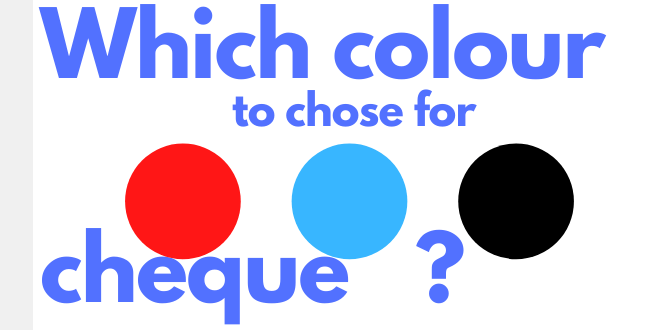In short Yes, but why not read along with this article and you will know this. While writing a cheque this question always stumble upon every cheque holder’s mind, whether the colour you are choosing is actually eligible or not.
Cheque consists of Drawer, Drawee, and Payee and this is a mode of payment for the Drawer to the payee. A cheque is a piece of paper that has the following fields filled by the Drawer and the Payee will present that cheque to the Drawee (i.e Bank) and would get paid.
The following fields that need to be filled are – Date, Name of the organization or receiver name, Amount in words, and the other field for in number, followed by the account number of the Drawer and the Drawer’s signature.
There are different types and the difference between cheque and demand draft is elaborated.
Why does the bank officials say no to red pens?
Scientifically, red has the highest wavelength which means, it triggers human eyes to look at the colour as used in traffic lights and for brakes in cars but that’s the case for certain places where immediate action should be taken.
In writing, schools and colleges don’t allow the red colour to be used for their primary pen. This is because the teachers use it for correcting papers to take away students’ look from their writing to the teacher’s correction, that’s not the case that students cannot use red pens but it’s a rule of thumb to follow.
That is also the case for bank customers, they can use red but the red fades away. There are other causes to avoid like the scanners used to scan the cheques and to keep a record develop the problem because red isn’t so red that means not so dark as black to notice on the cheque.
Not only this but many banks reject cheques written in red colours. And in turn, this could cost you a penalty.
Is there any colour psychology behind writing a cheque with a specific colour ?
No, not so specific but red is avoided because of it’s fading nature that it shows when used, a naked eye can see more clearly a black for a time because of its darkness and why do people don’t say to avoid green, yellow and others that may be out there, as they are not so easily available and not a primary colour.
Colours such as black and blue are widely used for writing as it’s crystal clear and comfortable to look at our eyes. In banking, red colours also play a vital roll-on rejection or in false documents.
Can you write a cheque in two different inks ?
No, as the colour variations can cause problems like scanning the text. So strictly NO. This can cause a problem for the Payee because the Drawee can reject it. The bank allows you only a single colour to write the cheque in full.
Banks will reject the cheque for sure and will be considered spam and unethical.
As per Madras High Court came to a verdict, that ink alternation will be considered void by the bank.
Will a bank cash a cheque written in red ink ?
Probably yes and no, because avoiding red pen anywhere is a general practice and instead of using a black and blue pen is a good practice.
And the recommended advice would be to use a black or a blue pen because many banks don’t allow customers to use red colour, and might reject the payee, so it’s a safe game to avoid all other colour pens except black and blue.
Can a Cheque be written in black ink ?
Yes, because black has a distinct and dark colour to provide better readability for the humans and the scanners too. Now a day, black inks are used everywhere and considered a good practice to adapt to this.
As per the documents are printed in black, writing with black pen contrasts more than blue preferably. And in terms of professionalism, black is better than blue. And the black inks works really well with printers and scanners as opposed to blue inks.
What colour ink is legal ?
As per previous generations, black was used in officers and for official uses. And till now, but blue is introduced as a legal too. But black ink looks more authoritative than blue ink.
what color pen should be used when writing cheque and why ?
Now, the main question where everything will be sorted out is which is the best colour ink to write in cheque and why should we?
The clear answer would be both black and blue however when to chose between blue and black, black is more professional and widely used as well as legalized too. The main thing is about rejecting the red, green, yellow, and the other inks that might come into your mind.
And why to chose them because they are the most standard and good practice to use them in our lives. The other colours such as green, yellow, red and blue, etc. are used for colour books and for projects for kids but are not for serious works that are used in offices, colleges, and other higher institutions and authorities.
Should gell pen or use and throw be used while writing in cheque ?
This is a good question as the use and throw is best for writing cheque as it doesn’t spread over the cheque like the gell pen, gel pens are usually avoided for sensitive and areas where overwriting is prohibited and if there’s any confusion or mistake corrected over the cheque it gets cancelled.
So, gel ink can spread over the cheque, turn the back of the cheque with deep ink.
Some of the best pens you can buy right now on amazon
On Amazon, there are many other types of ball pens and gel pens so ease your journey I have chosen a set of Cello blue pen box which is really a high-quality product and the best for your cheque.
However, don’t worry after saying so a lot about black inks, I haven’t forgotten to choose the best pen for your cheque. Again Cello’s 10 pens in a pack is well worth it to take.
If you wish to have both at the same time, choose Nataraj’s pen pack that offers both the blue and the black pen as a set.

